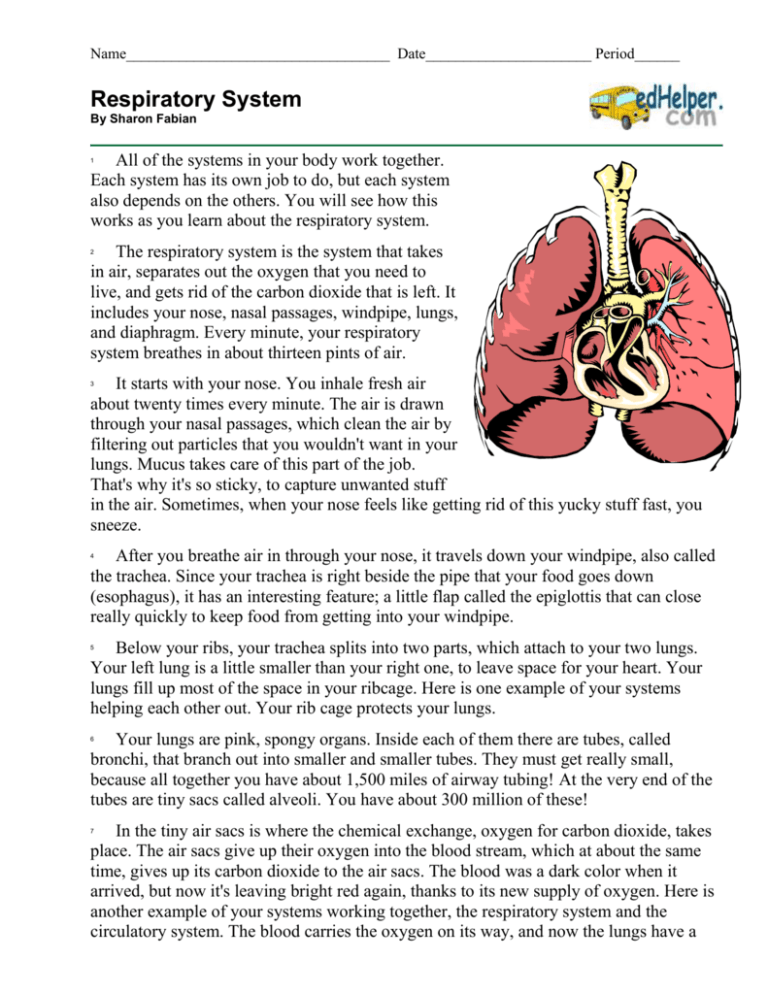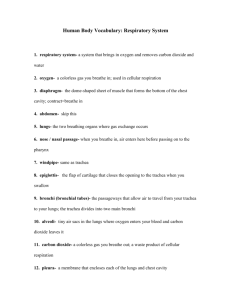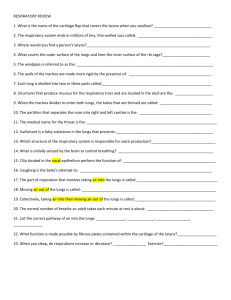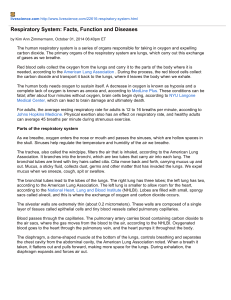Respiratory System Worksheet
advertisement

Name___________________________________ Date______________________ Period______ Respiratory System By Sharon Fabian All of the systems in your body work together. Each system has its own job to do, but each system also depends on the others. You will see how this works as you learn about the respiratory system. 1 The respiratory system is the system that takes in air, separates out the oxygen that you need to live, and gets rid of the carbon dioxide that is left. It includes your nose, nasal passages, windpipe, lungs, and diaphragm. Every minute, your respiratory system breathes in about thirteen pints of air. 2 It starts with your nose. You inhale fresh air about twenty times every minute. The air is drawn through your nasal passages, which clean the air by filtering out particles that you wouldn't want in your lungs. Mucus takes care of this part of the job. That's why it's so sticky, to capture unwanted stuff in the air. Sometimes, when your nose feels like getting rid of this yucky stuff fast, you sneeze. 3 After you breathe air in through your nose, it travels down your windpipe, also called the trachea. Since your trachea is right beside the pipe that your food goes down (esophagus), it has an interesting feature; a little flap called the epiglottis that can close really quickly to keep food from getting into your windpipe. 4 Below your ribs, your trachea splits into two parts, which attach to your two lungs. Your left lung is a little smaller than your right one, to leave space for your heart. Your lungs fill up most of the space in your ribcage. Here is one example of your systems helping each other out. Your rib cage protects your lungs. 5 Your lungs are pink, spongy organs. Inside each of them there are tubes, called bronchi, that branch out into smaller and smaller tubes. They must get really small, because all together you have about 1,500 miles of airway tubing! At the very end of the tubes are tiny sacs called alveoli. You have about 300 million of these! 6 In the tiny air sacs is where the chemical exchange, oxygen for carbon dioxide, takes place. The air sacs give up their oxygen into the blood stream, which at about the same time, gives up its carbon dioxide to the air sacs. The blood was a dark color when it arrived, but now it's leaving bright red again, thanks to its new supply of oxygen. Here is another example of your systems working together, the respiratory system and the circulatory system. The blood carries the oxygen on its way, and now the lungs have a 7 new job, to send the carbon dioxide up to your nose to be exhaled. A dome-shaped muscle just below your lungs, called the diaphragm, makes your lungs breathe in and out. When your diaphragm pulls down, it leaves space for your lungs to expand, and air pressure brings more air in. When your diaphragm relaxes, the space gets smaller and air is pushed out. 8 Your respiratory system is in communication with another system, your nervous system, too. Your brain, which is part of the nervous system, tells your lungs when it needs to breathe faster or slower. For example, if you are running, your lungs need to know to breathe faster to bring in more oxygen. 9 On its way out, the air passes over your vocal cords. This is where you make sounds to talk, sing, laugh, or yell, but that's another story. So the carbon dioxide goes out the same way the oxygen came in, and that's how your respiratory system works. 10 Copyright © 2007 edHelper 1. The average person breathes about _____ times per minute. 1,500 20 5 300 million 3. Your _____ protects your lungs. Ribcage Shirt Heart Skin 5. The diaphragm is a _____. Muscle Tube Chemical Cell 2. Another name for your windpipe is your _____. Trachea Bronchi Epiglottis Alveoli 4. The respiratory system brings in a chemical that we need, and gets rid of a chemical that we don't need. Name the two chemicals. Carbon and nitrogen Carbon dioxide and neon Nitrogen and oxygen Oxygen and carbon dioxide 6. Your respiratory system works along with which other systems? Nervous system and circulatory system Skeletal system and muscular system Both a and b Neither a or b 7. Your brain is part of your _____ system. 8. Your ribcage is part of your _____ Circulatory Skeletal Nervous Respiratory system. Skeletal Nervous Circulatory Respiratory Name___________________________________ Date______________________ Period______ A Healthy Respiratory System By Sharon Fabian If you like to play baseball, or dance, or swim, or just keep active, you will want to keep your respiratory system in top shape. Being able to breathe in lots of oxygen makes it easier to do any activity, and what you need in order to breathe in big breaths of oxygen is a strong and healthy respiratory system. 1 The two things that are really good for your lungs and the rest of your respiratory system are exercise and not putting anything into your lungs that is bad for them. 2 Aerobic exercises make your lungs strong and make you breathe in more oxygen. In fact the word aerobic has to do with your muscles using oxygen. Of course, you don't have to set a timer and do 1/2 hour of jumping jacks or other aerobic exercises every day. Any activities that get you moving are good. Just getting outside is a good start. People seem to think of more active things to do once they are out in the sunshine, and away from the TV. 3 Some things are just not good for your lungs. These include things that you are allergic to, pollution, and cigarette smoke. 4 Many people are allergic to something. If you are allergic to cats, or dust, or pollen, you probably try to stay away from those things as much as possible. 5 Air pollution is hard on your lungs too. When there is air pollution in the area where you live, you can't just stay away from it like you can stay away from a cat or a dog. There are several sources of air pollution. How lungs are impacted depends on the amount of time exposed to the pollutant, one’s general health condition and activity level at the time of exposure, and the pollutant. In Sacramento, the main pollutants for concern for residents are: ozone, particulate matter 10 um and 2.5 um. Ozone (O3) is important to protect against excessive ultraviolet radiation (remember the ozone hole) but in the breathing zone, ozone causes lung irritation and is the main ingredient of urban smog. The particulate matter is made of small particles that are invisible – microscopic bits of dust, dirt, soot, smoke and liquid droplets. These particles get into the lungs and reduce resistance to respiratory infections, aggravate lung and heart disease, injure lung tissue and carry cancer-causing toxins deep into our lungs. The smaller the particles the deeper into are lungs these particles travel. 6 Cigarette smoke can severely damage your lungs. It kills many thousands of people every year. Smoking causes 87% of the lung cancer in the United States. It causes other diseases like emphysema and bronchitis. It increases your risk of having a stroke, a heart attack, and mouth cancer. 7 Lung and other respiratory system damage are caused by chemicals that are in the cigarette smoke. Your trachea is lined with little hairs, called cilia, which filter the air you breathe to keep dirt out of your lungs. Chemicals in smoke damage the cilia so they cannot work as well. Inside your lungs are many tiny air sacs that manage the job of getting oxygen from the air to the rest of your body. Smoke breaks down the walls of these air sacs. After cigarette smoke has damaged lots of cells in a person's lungs, cancer cells may start to grow instead of more good cells. 8 Lots of smokers try to quit. Some are successful, but many are not. Some people quit for a while, but then begin smoking again. Beating the habit is not easy, because addiction to smoking affects a person both physically and mentally. 9 According to the American Cancer Society, 90% of new smokers are children and teens. This is especially sad because we already know how hard it is to stop smoking. So if you don't start, you are doing yourself a wonderful favor! With good, strong lungs to supply you with plenty of oxygen, you can take up a new habit, maybe participating in swim meets, or country line dancing, or playing first base, or . . . 10 Copyright © 2007 edHelper 1. Your respiratory system is the system that you use to breathe. False True 3. The word aerobic ____. Is another word for lungs Has to do with muscles using oxygen Has to do with allergies Means any team sport 5. According to this article, cars and factories cause _____ pollution. Air Water Light Noise 7. Smoke can damage _____. Cilia Air sacs Other parts of the respiratory system 2. You should avoid aerobic exercise if you want to keep your lungs healthy. False True 4. _____ have allergies. Few people Only old people Only people in the US Many people 6. Smoking causes _____ of the lung cancer in the US. Well over half Slightly more than half Less than half Exactly half 8. Why do you think that more people start smoking every day, even though they know how dangerous it is? All of the above A Healthy Respiratory System - Answer Key 1 True 2 False 3 Has to do with muscles using oxygen 4 Many people 5 Air 6 Well over half 7 All of the above Respiratory System - Answer Key 1 2 3 4 5 6 7 8 20 Trachea Ribcage Oxygen and carbon dioxide Muscle Nervous system and circulatory system Nervous Skeletal









